Archived Storm Damage Blog Posts
Understanding the Saffir-Simpson Hurricane Wind Scale
1/9/2024 (Permalink)
Hurricanes are powerful and destructive natural disasters, capable of causing extensive damage to homes, infrastructure, and the environment. To accurately assess and communicate the intensity of hurricanes, the Saffir-Simpson Hurricane Wind Scale is used worldwide. In this blog, we will delve into the Saffir-Simpson Hurricane Wind Scale to help you understand its categories, wind speeds, and the potential impacts associated with each level.
The Purpose and Origin of the Saffir-Simpson Hurricane Wind Scale
- Understanding the need for a standardized measurement system for hurricanes.
- Tracing the history and development of the Saffir-Simpson Hurricane Wind Scale.
Categories of the Saffir-Simpson Hurricane Wind Scale
- Explaining the five categories (1 to 5) of the scale and their criteria based on maximum sustained wind speeds.
- Detailing the wind speeds, storm surge, and potential damage associated with each category.
- Highlighting the factors that contribute to a hurricane's category, such as pressure and size.
Assessing the Impacts of Each Category
- Exploring the potential damage to structures, trees, power lines, and infrastructure at each category level.
- Discussing the flood risks, storm surges, and coastal erosion associated with different categories.
- Highlighting the risk to human life and safety under various hurricane categories.
Understanding the Limitations of the Scale
- Acknowledging the scale's focus on wind speed and the exclusion of other factors like rainfall and tornadoes.
- Emphasizing the role of preparedness and evacuation plans regardless of the hurricane's category.
Importance of Public Awareness
Encouraging individuals to stay informed about approaching hurricanes and to remain updated with the latest forecasts.
Promoting the significance of heeding evacuation orders and following emergency management guidelines based on the projected category of an approaching hurricane.
The Evolving Role of the Saffir-Simpson Scale
- While the Saffir-Simpson Hurricane Wind Scale has been a valuable tool in assessing hurricanes, it is important to note that our understanding of hurricanes continues to evolve.
- Researchers and meteorologists are continually studying and refining our knowledge of hurricanes, including factors beyond wind speed that contribute to their intensity and impact.
- Efforts are being made to incorporate additional variables such as rainfall, storm size, and potential storm surge into hurricane assessment and communication systems.
- The aim is to provide an even more comprehensive understanding of hurricanes and their potential threats, enabling better preparedness and response strategies for communities and individuals.
Understanding the Saffir-Simpson Hurricane Wind Scale enables individuals, communities, and emergency management organizations to better prepare for and respond to hurricanes. By recognizing the categories' associated wind speeds and potential impacts, we can make informed decisions, protect lives, and minimize property damage. Stay vigilant, stay informed, and prioritize safety when confronted with the forces of these formidable natural phenomena.
Effective Fallen Tree and Debris Cleanup After Storms in the Greater St. Louis Area
9/12/2023 (Permalink)
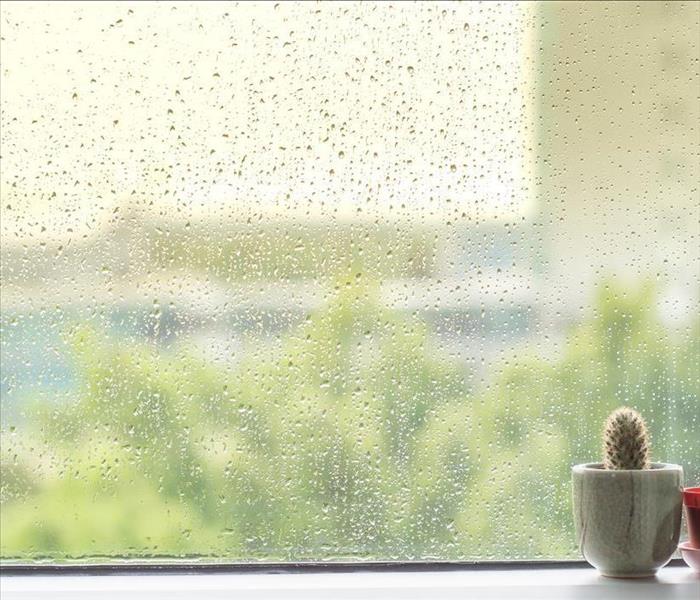 By following these steps, you'll be better prepared to tackle the challenges posed by nature's forces.
By following these steps, you'll be better prepared to tackle the challenges posed by nature's forces.
In the heart of the St. Louis area, nature's fury can leave behind a trail of fallen trees, debris, and chaos after storms. As a homeowner or property owner, knowing how to handle debris and fallen trees is crucial for a safe and swift recovery. This blog serves as your comprehensive guide to efficiently cleaning up your space after storms, allowing you to restore your property and peace of mind.
The Importance of Prompt Cleanup
After a storm subsides, it's essential to tackle debris and fallen trees as soon as possible. Here's why:
- Safety First: Fallen trees and debris can pose immediate safety risks to you, your family, and your property.
- Prevent Further Damage: Addressing fallen trees quickly prevents secondary damage to structures, fences, and utilities.
- Pests and Mold Prevention: Debris accumulation can attract pests and lead to mold growth if not addressed promptly.
Step-by-Step Debris and Fallen Tree Cleanup
- Safety Precautions: Before you start, ensure your safety by wearing appropriate gear and checking for hazards like downed power lines.
- Assess the Situation: Evaluate the extent of the damage. Identify any trees or branches that may have compromised structures.
- Clear Walkways and Entry Points: Begin by clearing pathways, driveways, and entry points to ensure safe access.
- Branch Removal: Trim and remove smaller branches using proper tools, such as pruning shears and handsaws.
- Large Tree Removal: For fallen trees or large branches, consider hiring professional tree removal services, especially if they pose risks.
- Dispose of Debris: Organize debris into separate piles for recycling, composting, or disposal. Check local regulations for guidelines.
- Assess Structural Damage: Inspect your property for any structural damage caused by fallen trees or branches. Address repairs promptly.
- Grind Stumps (if needed): If you remove a tree, consider grinding the stump to prevent regrowth and enhance aesthetics.
Collaborate with Professionals
In cases of extensive damage or challenging tree removal, enlisting the help of professionals is wise. Certified arborists and tree removal experts have the expertise and equipment to handle large-scale cleanup safely and effectively.
Utilize Local Resources
Check with local authorities for guidelines on debris removal, disposal locations, and any assistance programs that may be available after severe storms.
Insurance Considerations
If fallen trees or debris cause damage to your property, consult your homeowner's insurance policy. Document the damage with photographs and descriptions to facilitate the claims process.
Preventing Future Damage
While you can't prevent every storm, some measures can minimize the impact:
Regular Tree Maintenance: Prune dead or weakened branches before storms to reduce the risk of falling.
Assess Tree Health: Periodically assess your trees' health to identify potential hazards and address them proactively.
Secure Outdoor Items: Secure outdoor furniture, grills, and other items that can become debris in strong winds.
Plant Wisely: Choose trees and shrubs that are well-suited to your area's climate and soil conditions to prevent uprooting.
Debris and fallen trees in the aftermath of St. Louis storms may be daunting, but with the right approach, you can restore your property's beauty and functionality. By following these steps, collaborating with professionals, and taking preventive measures, you'll be better prepared to tackle the challenges posed by nature's forces. Reclaiming your space after a storm is not just about cleaning up – it's about reclaiming your peace of mind and your property's potential.
Unlocking Cost Savings: Effective Strategies for Property Maintenance
6/29/2023 (Permalink)
 Saving money on property maintenance cost requires proactive and strategic approach.
Saving money on property maintenance cost requires proactive and strategic approach.
Property maintenance costs can quickly add up, eating into your budget and hindering financial growth. Whether you're a homeowner, property manager, or investor, finding ways to save money on property maintenance is essential for long-term success. In this blog, we will explore practical strategies that can help you minimize expenses while ensuring your property remains in excellent condition.
Prioritize Preventive Maintenance
Prevention is the key to reducing maintenance costs. By implementing a proactive approach, you can identify and address potential issues before they escalate into costly repairs. Regular inspections, routine maintenance, and timely repairs can help you catch small problems early on, saving you significant expenses in the long run. Create a maintenance checklist and schedule regular inspections to stay on top of necessary tasks.
Perform Regular Cleaning and Upkeep
Regular cleaning and upkeep not only enhance the aesthetic appeal of your property but also contribute to its longevity. Create a cleaning schedule that includes tasks such as gutter cleaning, window washing, pressure washing, and landscaping. By regularly maintaining these areas, you can prevent dirt, debris, and other build-ups that could lead to more significant problems down the line.
DIY vs. Professional Services
While it may be tempting to handle all maintenance tasks yourself, it's essential to assess your skill level and the complexity of the job. Some tasks, such as minor repairs and basic maintenance, can be done DIY-style, saving you money on labor costs. However, for more specialized or complex tasks, it's often wiser to hire professional contractors. Attempting unfamiliar repairs could lead to costly mistakes.
Develop Relationships with Reliable Contractors
Building relationships with reliable contractors can provide you with peace of mind and potential cost savings. Seek out contractors who have a good reputation, offer competitive pricing, and provide quality workmanship. By working with the same contractors consistently, you can negotiate better rates, benefit from their familiarity with your property, and receive priority service in emergencies. Additionally, they can provide valuable advice on maintenance strategies and help identify cost-effective solutions.
Focus on Energy Efficiency
Energy costs can account for a significant portion of property maintenance expenses. Implementing energy-efficient practices can help reduce utility bills and lower overall maintenance costs. Install energy-efficient lighting, such as LED bulbs, and consider upgrading appliances to energy-saving models. Proper insulation, sealing air leaks, and using programmable thermostats can further enhance energy efficiency. Conduct regular energy audits to identify areas where improvements can be made.
Plan for Long-Term Maintenance
Developing a long-term maintenance plan allows you to anticipate and budget for future expenses. Identify the lifespan of major components, such as roofing, HVAC systems, and plumbing, and plan for replacements or repairs accordingly. By spreading out the costs over time, you can avoid sudden financial burdens and take advantage of competitive pricing through proper research and contractor selection.
Saving money on property maintenance costs requires a proactive and strategic approach. By prioritizing preventive maintenance, performing regular cleaning and upkeep, assessing when to hire professionals versus handling tasks yourself, building relationships with reliable contractors, focusing on energy efficiency, embracing technology, and planning for long-term maintenance, you can effectively reduce expenses without compromising the condition of your property. Remember, investing in proper maintenance is a smart financial decision that ensures your property remains a valuable asset for years to come.
The Hidden Problem in Your Home
11/1/2022 (Permalink)
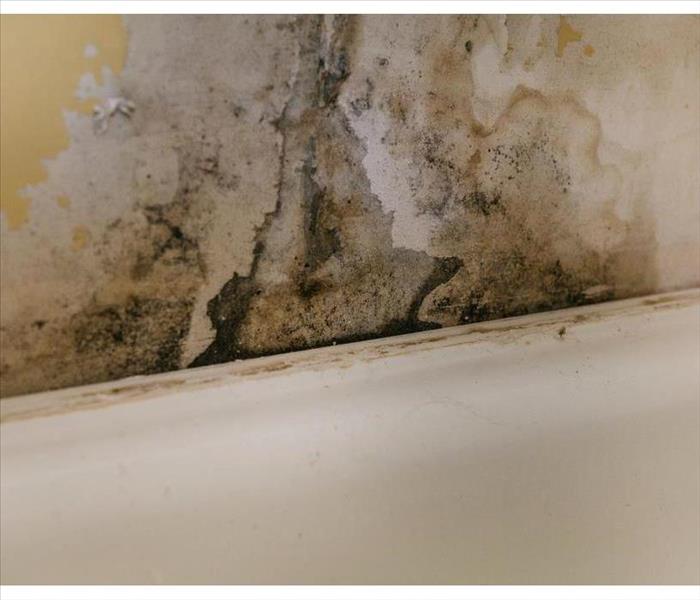 Water damage can lead to mold growth.
Water damage can lead to mold growth.
Home Flood Problems
If you have a feeling that you haven't caught all the storm damage in your home, you are probably right. There are plenty of places where mold might hide. That sinking feeling isn't paranoia; it's more likely a combination of common sense and your own intuition telling you that your home flood problems are not over.
There are a few times you should call up a restoration company to finish off your water damage repairs, such as:
- If you smell something musty or rotten
- Moldy patches reappear
- Your house's air seems more humid than normal, or certain surfaces seem damper
Trust Your Intuition
It might be difficult to gauge certain aspects of your home flood remediation process, especially if you've done some of the work yourself and contracted out other tasks. The best guideline is to trust your feelings. You have likely developed a subconscious knowledge of certain things about your home, such as how fast mildew appears in a shower enclosure. If you're getting more water-related issues than you did before the flood, it could be a sign of a hidden problem.
Follow Your Nose
The human sense of smell is amazing; you have the ability to pick up certain scents in minuscule quantities. If it seems musty or slightly rotten to you, water might remain soaked into some of the materials in your home.
Trust All Your Senses
Your sense of touch might also prove to be a valuable ally when detecting invisible water damage on your property. Like most houses in Brentwood, MO your property probably has many places for water to hide. You might be harboring moisture in your crawlspace, your attic, under your floor, or even in the spaces in between your walls. This typically manifests in many ways, such as a humid environment or tile floors that sometimes seem cold and wet, for example.
Nobody wants to do a home flood restoration job over and over. However, you might have a hidden problem that needs some work. Trust your instincts if you think you have an issue. Water damage left alone simply causes more issues in the future.
How to Avoid Commercial Storm Damage
9/22/2022 (Permalink)
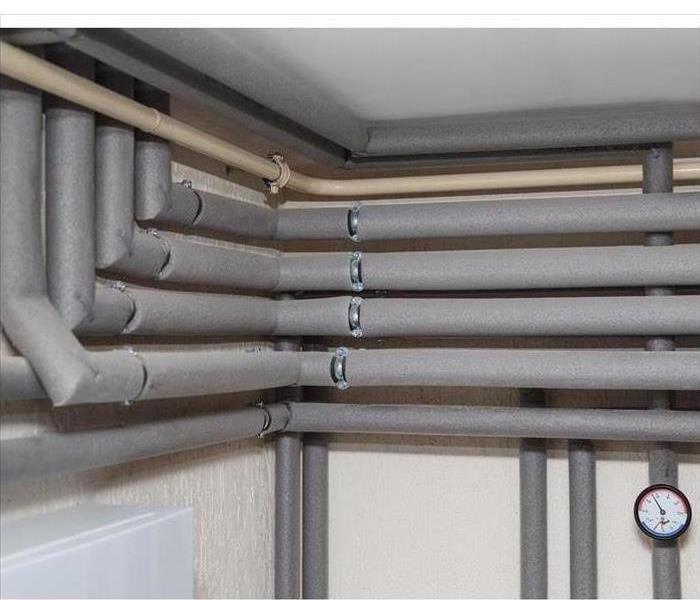 Insulate your building's pipe
Insulate your building's pipe
Don't Let A Winter Storm Derail Your Business
A winter storm can occur at any time so it's vital that you're prepared to protect your commercial building in Brentwood, MO. Taking the proper preventative measures can help ensure business continuity, avoid unnecessary property damage and, most importantly, keep your employees safe.
1. Sign Up for Emergency Alerts.
It's almost impossible to prepare for storm damage if you don't know what's going on. There are several alert systems available that can help you stay up to date on severe weather activity. It's just as important that you listen and abide by the authorities' instructions during the storm as well.
2. Keep Your Gutters Clean.
You should regularly remove debris from your building's gutters regardless of the weather. When your gutters and pipes are obstructed, they cannot drain water off of the roof properly, which can result in pooling and flooding.
3. Insulate Your Building's Pipes.
A winter storm puts your building's pipes at risk for freezing over. When water freezes, it expands, which puts unnecessary stress on your pipes and can ultimately result in a pipe break. You can prevent this by adding insulation to rooms with exposed piping, or applying insulating products, such as heat tape or pipe sleeves, directly to exposed piping.
4. Trim Overgrown Tree Branches.
High winds can transform overgrown tree branches into dangerous projectiles. Trimming back excessive plant growth is the best way to prevent a tree branch from hurling itself through your window.
5. Install a Backup Generator.
Some storms might not warrant an evacuation. If the authorities say that it's safe enough to remain in the building, you want to make sure you can keep working. Installing a backup generator is a great way to ensure that your building has a steady power supply throughout the duration of the storm.
Don't let a winter storm derail your business and inflict unnecessary property damage. The above methods can help prevent damage, but they cannot guarantee your complete safety. Contact storm remediation experts if your property has suffered physical damages.
4 Tips to Prevent a Sewage Backup
6/2/2022 (Permalink)
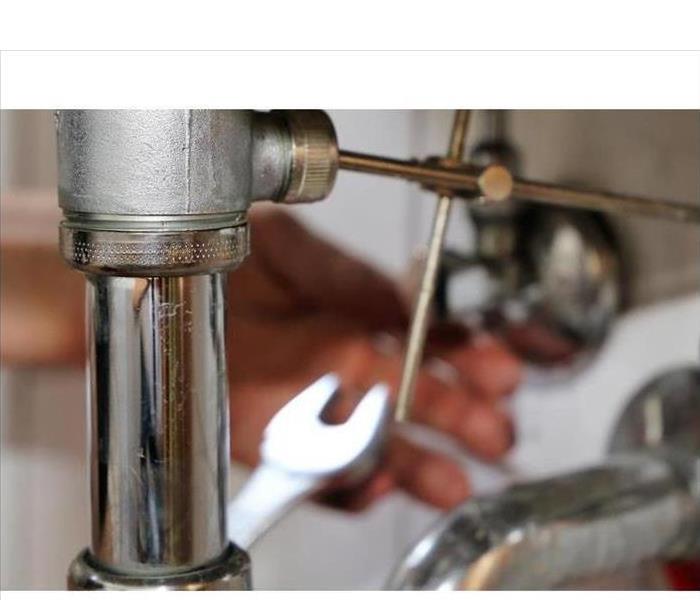 Regularly check plumbing fixtures.
Regularly check plumbing fixtures.
Four Things You Can Do To Prevent a Backup In Your Home
Going about daily life rarely comes with thinking about where your waste goes. That quickly comes to the forefront when a sewage backup happens in your Rock Hill, MO, home. At the basic level, this happens when water flows backward into the home. Common culprits include flooding, storm damage, blockage from roots, and broken pipes. Below are four things you can do to help prevent a backup in your home.
1. Avoid Clogs
Sinks and toilets are designed for certain things to be flushed away. In the kitchen, be sure not to pour grease or oils down the drain. They can solidify, blocking the water flow. Drain traps can be used to catch larger pieces of food that don’t easily break down. Consider cleaning drains once a month. This can be as simple as using a mixture of baking soda, vinegar, and water. When it comes to toilets, always remember that human waste and toilet paper should be the only things being flushed.
2. Inspect Plumbing
Instead of waiting for sewage waters to rise and needing a plumber to provide sewer cleaning services, regularly check plumbing fixtures. Ensure there are no leaks or damage that could result in water overflowing the main sewer drain.
3. Install a Backwater Valve
Although they may not be suitable for every home, these valves can be a benefit for many others. It is designed to detect backward flow while still letting water from fixtures easily flow out of the home. Once it detects high levels, a flap on the valve closes to keep the unwanted water out.
4. Replace Old Lines
In more established areas, the sewer lines may be made of metal or clay. Tree roots and rocks can eventually lead to cracks and breakage. If it seems you need to call a plumber more often than you should, it might be time to replace these lines with advanced plastic or PVC pipes.
If a backup happens, it doesn’t have to mean long-term damage and odors. Flood, water, and mold damage experts can quickly clean up the mess and make the right repairs to get your home back to normal.
Why Storm Shutters Are Important
5/25/2022 (Permalink)
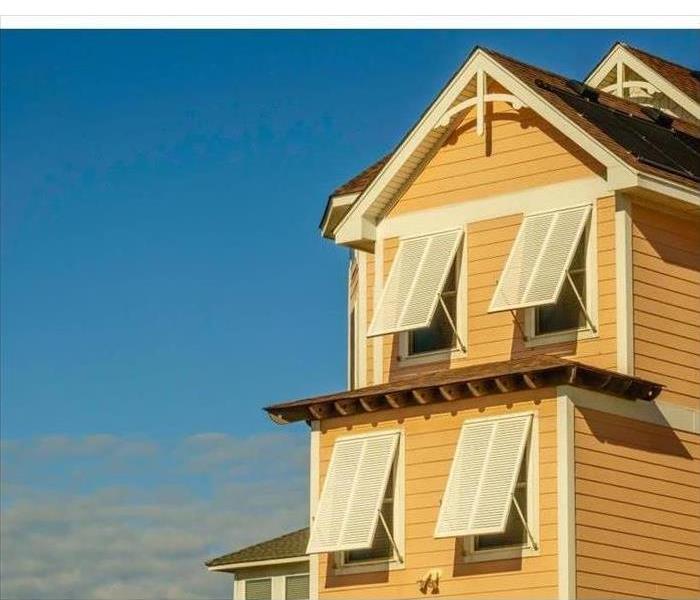 Storm shutters in a Brentwood, MO home.
Storm shutters in a Brentwood, MO home.
Different Types Of Shutters And Their Prices
One of the most important aspects of owning a house is to take every step possible to protect your home. It is vital for homeowners who live in states that are at high risk for hurricanes and high winds to install storm shutters, which are coverings that go over windows to protect them. They keep homes safe in hazardous weather and protect the interior as well as the exterior. The following explains the different types of shutters and what their prices are.
1. Colonial
These permanently-mounted storm shutters offer a pleasing aesthetic appeal as well as protection from high winds. They mount to the window and come in a variety of designs and materials, including wood and polycarbonate. The cost for these shutters is typically around $200-$500 per window.
2. Bahama Hurricane Shutters
In addition to offering storm protection, these shutters are ideal in hotter climates as they provide optimal shade to a home. They are hinged and mounted to the top of windows. The average cost is usually about $15-$20 per square foot.
3. Accordion Shutters
These storm shutters are usually made of metal and must be manually operated by the homeowner. They are in a box that is bolted around the windows. The cost is around $15-$25 per square foot.
4. Storm Panel
Storm panel shutters are only placed on windows before severe weather strikes and are usually made of aluminum, polycarbonate or steel. These usually cost about $7-$15 for each panel.
5. Plywood
Plywood is an option for quick and temporary shutters. The material, at $1 per square foot, is the cheapest option available. However, it can be difficult to install and is extremely heavy.
If you live in Brentwood, MO, it is crucial to protect your home from high winds. There are a wide variety of different shutter options available to cover your needs. Storm damage specialists can help with the proper installation of storm shutters so you can rest easy knowing your home is secure and safe from dangerous weather.
The Perils of Black Water
1/7/2022 (Permalink)
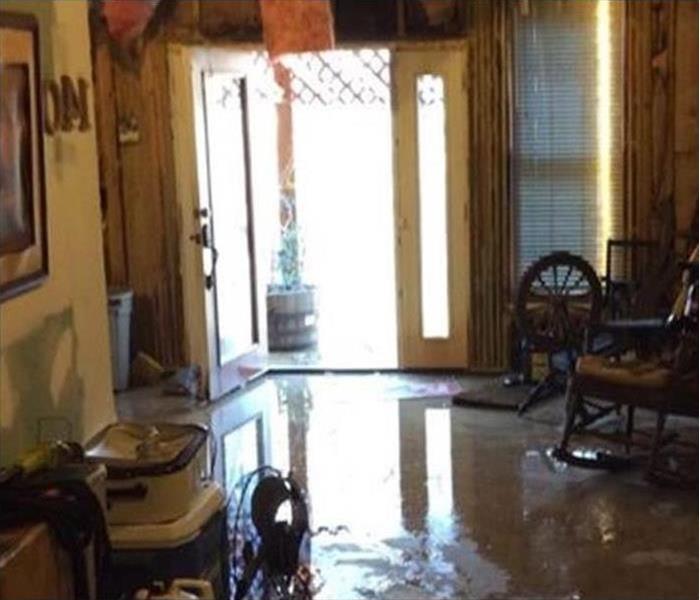 Floodwaters enter a home in Clayton, MO.
Floodwaters enter a home in Clayton, MO.
Water Damage Categories
After a flood occurs in Clayton, MO, the lingering effects of water take on many different forms. Three categories describe the different types of water damage that could exist after a disaster. The categories describe not only the intensity of the damage but also the method necessary for cleaning and repairing the destruction.
1. Category 3, the category into which all floodwater falls, is the most perilous and requires the most intensive cleanup. This type of water is called black water.
• What is it? Category 3 water comes from outside sources, such as sewage. Bacteria contaminate these sources to a dangerous level.
• What does it affect? The water impacts any surface that is porous. Contaminated water soaks into materials, rendering them dangerous to anyone who encounters them.
• How do you clean nonporous materials? Clean areas that are unable to soak up water by simply disinfecting surfaces.
• How do you clean porous materials? First, contain the affected areas by setting off the contaminated areas. Then, cut out materials containing sewage. Replace with new parts.
2. Category 2, called grey water, describes damage due to water that is somewhat contaminated, such as water from the dishwasher. The water will not make you sick unless you drink a lot of it. The water damage is cleaned similarly to Category 1. Technicians may additionally use a disinfectant.
3. Category 1 describes damage due to clean water, such as a broken pipe. To clean, technicians simply remove water from affected materials with an extractor, drill holes under baseboards to allow air flow, and arrange air movers and dehumidifiers to dry things out.
When you begin the process of cleaning and repairing destruction due to water, first determine the category of the damage. Use this knowledge to determine how to safely and efficiently disinfect and restore affected and contaminated building materials. Remember that water damage due to category 3 waters is perilous. Avoid contact with contaminated water or materials. The water will not harm you if you know what it is, what it affects, and how to clean it.





 24/7 Emergency Service
24/7 Emergency Service






